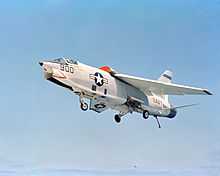Variable-incidence wing

A variable-incidence wing has an adjustable angle of incidence in order to reduce landing and take-off distances. It was patented in France on May 20, 1912 by Bulgarian inventor George Boginoff.[ 1]
One of the earlier designs to use it was the Supermarine Type 322 of 1943 intended, though not adopted, for aircraft carrier use.
The necessary components add extra weight to the aircraft and increase maintenance costs. In some aircraft the benefits outweigh the costs, and variable-incidence functionality is incorporated into the design, most notably with the F-8 Crusader, although other designs have used it, such as the Martin XB-51.
No modern aircraft has used this design since the F-8, and it was omitted from the derivative, subsonic A-7 Corsair II due to lower landing speeds and weights.